#5 NW Front Street
Coupeville, Washington
John Robertson Home / Seaside Spa and Salon
John Robertson built this house in 1864. Although it was originally permitted as a mill he built a residence for himself instead.
1881 The building was moved back 10 feet to provide more room on Front Street for further development.
In the late 1940s it was remodeled by Jack & Margaret Rosenfield.
1905 Sarah Wanamaker purchased the building and used it as a residence.
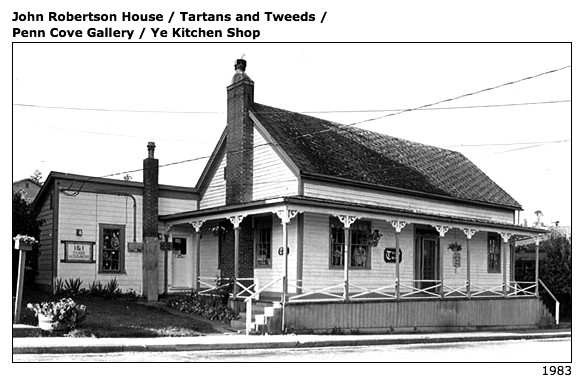
The Robertson House
From the Ebey's Landing Building & Landscape Inventory
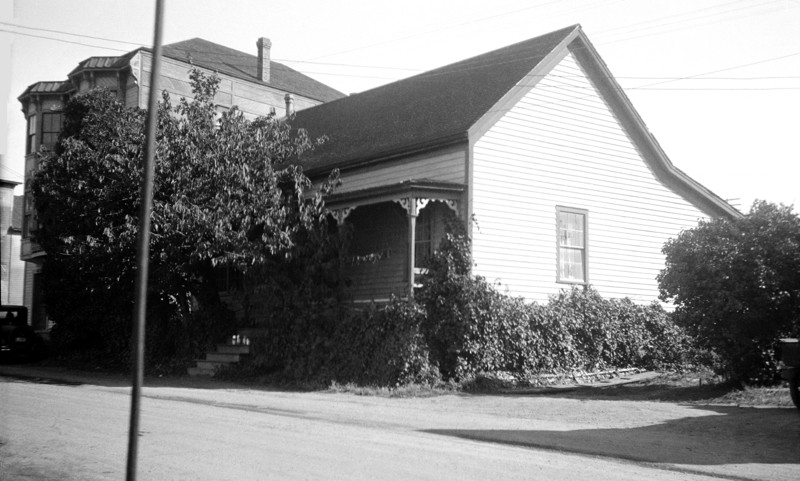
The Robertson House, 1937. To left is the Glenwood Hotel and a glimpse of the Circuit Theatre
Courtesy: Library of Congress
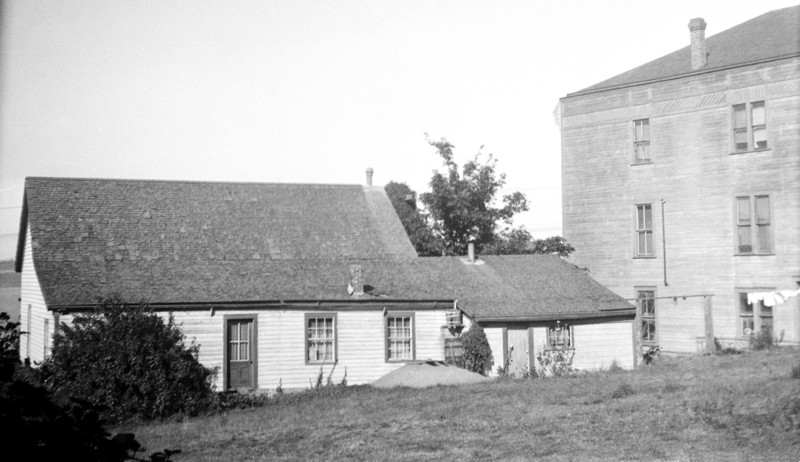
Rear of the Robertson House, 1937. The Glenwood Hotel is on the right.
Courtesy: Library of Congress
1971 Rose Brosseau opened and ran the Six Persimmons Restaurant.
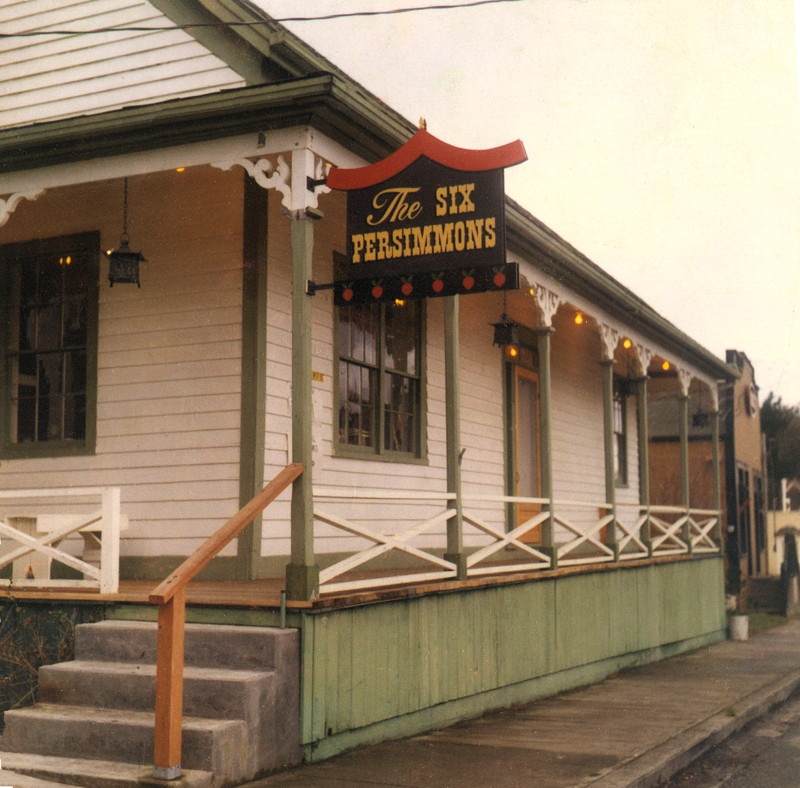
Six Persimmons Restaurant
*From an interview by Judy Lynn with Rose Brosseau and Shirley Bennett [Owner of Penny Farthing in the Glenwood], 2008
Judy: Rose, how did you happen to open the Six Persimmons?
Rose: We opened the restaurant and gift shop and our first customers were Gary and Mary Hedge. Mary suggested that I teach cooking classes. A year after opening the business I started cooking classes. The grocery stores didn't have any Asian vegetables and I had to pick them up in town (Seattle). Both Oak Harbor and Freeland grocery store owners then sent the managers to take cooking classes so they would stock ingredients. We were way ahead of the times.
Judy: How did you decide on a restaurant?
Rose: Mahlon pushed me into it. We had made trips to Hong Kong and Singapore and enjoyed their finger foods. I didn't have a clue as to business or a restaurant—I just did it. I enjoyed cooking. Mahlon thought I could do it. I wouldn't have done it without being pushed.
Judy: How did you come up the name, Six Persimmons?
Rose: I didn't want an average Chinese name. I was working at Children's Hospital and the Director of Volunteers, Barbara Sterling said "How about Six Persimmons?" I said, "What is that?" She laughed. I said, "Just because I'm Chinese doesn't mean I know everything." She explained that it's the name of a Chinese painting from the 12th or 13th century. The Chinese thought the artist's paintings were "too Zen" so all his paintings are hung in Japan. The Child Psychologist at Children's had a copy of the painting that I bought for $10. I still have it.
...
We took the entire main floor of the Robertson house. Mahlon stripped the layers of wallpaper off to the original boards. He took off the false ceiling in the gift shop. In the ceiling he found a horse harness and canvas sail. The kitchen was just as it had been. We did no remodeling. I cooked on a two-burner gas stove. It was very primitive. We did some remodeling when I started teaching and put in a counter. On the main floor, on the east side, to the left when you came in, was the dining room. It had a fireplace. The furnishings, round tables, were from a restaurant supply. The gift shop was on the right, or west side. Mahlon put in a counter and shelves that we bought from Rhodes Department Store (2nd street in Seattle) when they went out of business.
In the back of the building was a bedroom we used when we came on weekends. It later became an all-purpose living room. On the back east side was the kitchen. In the small room on the east side was where I taught my Chinese cooking classes.
....
Judy: What are you memories of the Six Persimmons on Front Street?
Shirley: Rose would do carry-out and bring me a double order of won ton soup and my own pot of tea. She introduced me to food from the Orient. I sort-of took your cooking class. I couldn't practice because I didn't have a kitchen. Rose and Mahlon taught me how to use chopsticks. She taught many people.
Rose: I brought lunch to Richard Priesing too (when he had a printing business on Grace Street). We used to have jook (rice soup) and spring rolls for the Coupeville Arts and Crafts Festivals. When the weather during the festival was cold they welcomed the jook. We had a stall on the grassy area behind the sidewalk, near the kitchen of the restaurant.
Rose: We had some famous people come to the restaurant. Senator Jackson came when he was campaigning. I was surprised that he was so short. We had Russian scientists and people would fly in to eat my food. KOMO employees came too. Molly McPherson would come and order "one time soup." (Won ton.)
*From an interview by Judy Lynn with Lee Anderst, 2008
Rose Brosseau's Six Persimmons on Front Street was our favorite place to go out to dinner. There was usually only one thing on the menu…it was very limited…and Mahlon (Brosseau) served. Rose gave cooking lessons. My mother was here in the late 70's and she and I took 3 lessons. The next summer we took another set. Then my mother moved to Coupeville. She kept taking lessons from Rose. Eventually there were 6 women Rose was cooking for. She said "I'm tired of cooking for you….let's cook for each other." I have recipes that were my mothers. The group was called The Six Chin's, and they cooked for each other. It was Betty Coyne, Lora Lee Sedgwick, Donna White, Louise Melby and I think Juanita Haugen. My mother was a fabulous Chinese cook. Everything I know I learned from mom and Rose. When Rose moved her shop to Grace Street my mom worked for her for years. Rose had pre-prepared pot stickers and won ton soup. Mary Argent worked for her as well.
*From an interview by Judy Lynn with Louise Holloway Stanley, 2009
The Six Persimmons (John Robertson's house) was an Asian restaurant. Friendly Rose Brosseau ran the restaurant cooked and stocked the store with great buys. I would have a bowl of rice and other tasty foods. She had goods from China for sale. My kids would come in after school - it was like a little museum for them to look around in her store. She also sold wonderful cooking utensils.
1980 - Del Bennett & Frances Waller - antique shop in annex for 1 year
1980 - The Six Persimmons moved to Grace Street. Patrick's Imported Apparel moved in from Mariner's Court.
1981 - The Brosseau's sold the building to Jerry and Theresa Saia. Katie Zimmerman & Carole Amtmann bought Patrick's Apparel and changed the name to Tartans and Tweeds. Around this time the outside stairs were rebuilt.
*From an interview by Judy Lynn with Jerry Saia, 2009
Judy: When and why did you buy the John Robertson house at #5 Front Street?
Jerry: Theresa and I bought it in 1982. We were looking for a little investment in Coupeville and Theresa wanted an area for an art studio. The building came up for sale by Mahlon and Rose Brosseau and we made an offer—I think $135,000—and it was accepted. The attic area had never been used and was an area that needed work. I found old fishing poles, a trunk, and a lot of junk. It was a catch-all. I worked on that to build a studio and other renovations on the building.
Judy: Tell me about the ghost story.
Jerry: It was one event in the downstairs lobby. I was on a 12' ladder working on the ceiling and the ladder started to fall over. I'm not superstitious but somebody grabbed me to keep me from falling. I thought maybe I should get out of there and did.
It's a large piece of property—30 thousand square feet I think and goes up the hill in the back. There's still a barn on the back.
We wanted to turn the attic into something usable. I applied for a permit to put in dormers and brought the plan to Historical Society. They commented that they didn't know of a saltbox building with dormers. I was an architectural major and I found saltbox buildings with dormers. They couldn't deny it and gave me a permit.. I cleaned it up, put up sheet rock and it turned out to be a nice space that Theresa used for a studio.
The building was built as a pole building. The beams are 12 x 12 full length and put together with dowels, not nails. I tried to drive nails into the old growth timber and couldn't.
Judy: Have you heard it was ever used as a gristmill?
Jerry: I don't think it was a gristmill. I had a building inspector look at it and he said it could have held a locomotive with the heavy beams.
The stairway to the attic ran straight up without a landing, I knew it wouldn't be safe for customers so we put in a landing. Now Theresa has a beautiful apartment up there. She's put a lot of work in it and invested a lot of money—about a third of the original price in repairs. It's had a couple of roofs since we bought it. Theresa did a ton of work under the building. There were some beetle problems and a lot of the old timbers had to be removed.
.....
Judy: What else do you remember about the building?
Jerry: The tenants were a lot of fun. Sharon [Werner], the owner of The Gristmill Bake Shop [located at the back of the building], made some of the best sandwiches. The owners of Tartans and Tweeds [Katie Zimmerman and Carol Amtmann] were lovely to work with. Helen Scott [I&I Glass] was grouchy but a kick.
Phyllis Jackson [Ye Kitchen Shoppe] came in after Tartans and Tweeds moved across the street and was along-term tenant. Theresa and I divorced in 1991 and Theresa owns the building. Phyllis did a lot of work for her. If anything went wrong Phyllis would call Theresa. She was an in-house caretaker.
Judy: What did you do to the downstairs after you bought it?
Jerry: They were cosmetic things for the tenants - painting, carpeting, linoleum - no major construction.
Judy: What else do you remember about Front Street?
The War of the Roses film company leased our building. Because we were building owners we were able to mingle with the stars. I have a lot of nice memories. Front Street is a magnet it's in my blood.
1987 Tartans & Tweeds moved across the street to #4 Front Street [Now Knead and Feed]
April 1988 Ye Kitchen Shoppe was opened by Phyllis Jackson on the left side of the building.
*From an interview by Judy Lynn with Phyllis Jackson, 2008
Judy: How did you think of opening your shop?
Phyllis: Virginia [a friend and housemaid to Phyllis] and I had the idea of opening a tearoom. There was only one other house in town for sale and it did not have tearoom possibilities. Then she developed arthritis and we gave up on that idea. I was used to being busy and I wanted something to do so I opened Ye Kitchen Shoppe in April 1988. I rented the space from (the building owners) Theresa and Jerry Saia.
Judy: Why a kitchen shop?
Phyllis: As a child my grandfather and I played "store" with the hutch my grandfather had built, despite his having one arm. My parents were not together. I was raised by my grandparents until my father remarried.
Judy: Had you worked retail?
Phyllis: Only at a drug store in college.
We went into Holace [Perry] and Mickey's [Becker] shop - The Old Town Shop. They introduced themselves and we got to chatting. I said, "This looks like it would be fun". Holace said, "Everything has its downside". I talked with her several times and we went with them to buy cards for their shop and have lunch. One day she said, "Were you serious about that? I understand the store over there is available". I contacted the Saia's and made arrangements to rent it. Carol Amtmann and Katie Zimmerman had Tartans and Tweeds in that space and they wanted to move across the street. I rented from them until their lease was up and then I had a lease with the Saia's.
Judy: How did you find suppliers for your shop?
Phyllis: I liked to cook and liked pretty china. I didn't want to garden all the time. I liked tea and kitchen things - kitchen utensils and English china. Holace and Mickey told me what to do and I went to the 6100 building - the wholesale mart in Seattle. I went there and ordered things. I bought the shelving and displays to set up. Sunny Hanson was helpful and went with me and helped me pick out things. She also came and sat the shop. She was the hostess for the official opening.
Judy: Did the shop change over time?
Phyllis: Not much, I added to it. I carried very little food other than jams, scones and tea related things. I had shelves of different kinds of teas. Most things were tea related. I carried English china and teapots, linens and kitchen gadgets.
Judy: Who else was in the building?
Phyllis: Helen Scott was in the corner shop - the annex. She carried some things that were handmade by local people. The Gristmill was in back of my shop. The owner Sharon Werner, had a young baby that she brought to work and put it to sleep on the floor in Tartans and Tweeds. They had fantastic sandwiches with their homemade bread. It was very informal. They had the side room and if you were sitting alone people would introduce themselves and they would sit and eat with you.
After Helen Scott closed her shop in the annex, Caroline King opened a shop making vintage clothing. She later closed and moved to California.
Then Michele Kempes opened the Touch of Dutch in the annex.
After the Gristmill closed a Navy couple (her name was Linda) opened Chocolates Plus. She also made bread and pastries. When her husband got out of the service he opened a DVD shop back of the knitting shop on Main Street. Linda digressed and was working with the Coupeville Foot and Ankle clinic. Then I understand they moved out of the area.
In the front room, across from me, was the Llama import shop. I'm not sure of name. They weren't there very long.
Then Scott's Collection came into the front space, the back room and the one in back of me. There are 5 spaces on the main floor of the building. Ruth Hammer worked for Scott's Collection.
When Penn Cove Gallery moved to the corner of Grace and Front Tom and Gerri Strang moved their business from the Sill house on Coveland—where the law office is—to Front Street. The Strang's were in 4 of the 5 spaces with their handmade wooden crafts. The back rooms were vacant a long time before Strang's moved in.
A beauty shop was there before I closed. Sea Side Spa opened in there a year before I closed.
Judy: What was it like being in business on Front Street?
Phyllis: It was enjoyable and interesting. I met a lot of lovely people - many I keep in touch with now.
1989 - Folklore Ethnic Imports opened by Tom Stammer on the right front. Desserts First was opened by Linda Hoyt
1990 - The Scott Collection was opened by Sharon Scott in the right front.
1995 - New dormers added to North facade
1996 - A Touch of Dutch was in a back room but moved to Mariners Court for several years before relocating again to Grace Cottage at Grace and Front.
2000 Woodcraft of a Simpler Time opened by Tom and Gerri Strang in the right front. They moved the business from their previous location on Coveland Street.
*From an interview by Judy Lynn with Tom and Gerri Strang, 2010
Judy: Tell me about how you opened your shop, Woodcraft of a Simpler Time?
Tom: I had been doing wood working all my life, specializing in children's toys. I made toys for the kids when they were young…rocking horses and rocking airplanes. That progressed into doing craft shows in San Diego and Christmas shows in California. When we moved here we got into craft festivals. We did the Harvest Fest show in Seattle. We did the Coupeville and Anacortes festivals and the Christmas shows at Puyallup. Then we got tired of setting up.
Doctor John Bames had moved the Sill House from where the Condos are now, behind the Museum. (Note: The Sill house has been moved twice. Once from Front Street, north, then to Coveland, next to the Coupeville Inn. Dr. Bames was a radiologist who lived in Anacortes.
He had just finished the basement that supported the first floor. The first tenant was Sharon (last name not remembered) who opened Miss Emy Lou's Tearoom and Eatery on the street side. Bames said we could have the room in the back….or half of the first floor. We moved in March 1989. Sharon and her mother tried to make the tea house go for 6 months but I think she closed a little before Thanksgiving.
We then took over the whole first floor in March 1989.
Judy: What was it like being in business in Coupeville?
Tom: We liked it but the traffic pattern on Coveland wasn't that good. When spring time came and people had to park up farther the traffic increased. We had a movable sandwich board and the town would send us a note telling us we couldn't have a sandwich board. We brought it in for a week and then put it out again. A lot of folks thought we were crazy for opening a shop. We still did the Coupeville festival at the same time. Dr. Bame offered us economical rent and he did everything we asked….even installing the color carpet we wanted. He was interested in getting people in the building. Once we took over the first floor, it got out of hand. We had more business than we expected. We turned a profit in the first year and a half. Our business plan projected we would be profitable in 3 years.
I was doing the labor, making the toys at home in Teronda West. I had a work shop in the garage. Gerri was the front person. She has the gift of gab. We also carried the work of 50 other artists….mostly consignment.
Judy: What was your biggest seller?
Gerri: He was known for his military flag cases. The biggest selling items were the ducks and the flag cases. We had a variety of rocking items….airplanes, giraffes, and elephants. Lots of children's toys.
Tom: I tried woodturning but it was very slow. I took special orders. A woman bought a rocking airplane and wanted us to send it to England. It was 3' across 3 ½' tall. I had to disassemble and pack it. It would have cost 2 ½ times more in shipping so we sent it to Toronto and her brother sent it on a ship from there. The airplane sold for $435. Just to ship to Canada was $400.
Gerri: The toys brought such joy. We had a huge rocking elephant….five feet tall. A couple came in and the woman just had a big smile. Later we got a call from him and he said he hadn't seen her smile for months. Their children were killed and she had been depressed for months. He said, "I have to get her the elephant." He asked us to deliver it on her birthday to their home off-island. He wanted to make sure she opened the door and saw the elephant. She was full of joy. He sold their piano to buy the elephant. We delivered a lot of rocking toys.
Judy: What kind of wood did you use?
Tom: Rocking toys were generally pine—soft wood so it wouldn't splinter. The floor toys were maple.
Judy: How long were you in that building?
Tom: Almost 12 years on Coveland. We moved to Front Street in May 2000.
The first month [of 1989] we were on Coveland they were filming War of the Roses.
Judy: What do you remember about that?
Tom: It was raining. Michael Douglas was standoffish. Danny DeVito was friendly and funny. He would always have a crowd around him but you couldn't see him because he was so short. I spent 3 hours watching Michael Douglas put screens on the Johnson building and it was not in movie. (Note: a façade and porch roof had been added to the Johnson building at Coveland and Main Street. Michael Douglas was filmed putting screens on the false windows.) Kathleen Turner had an entourage. I remember the tent (at the corner of Main and Front) and the wind and rain machines.
We spent a lot of time on Coveland trying to get customers up to see us. We got in trouble for putting large posters on the kiosk at the entrance to the wharf.
....
Tom: John Bames originally planned to build an enclosed shopping center on the lot he owned at the northwest corner of Alexander and Coveland. It was have been retail on the bottom floor with an open courtyard in the center. The second floor would have connected with our first floor. The plans looked like a typical Pacific Northwest log structure. He gave it up because he knew he couldn't get it through the Coupeville community.
We didn't know John Bames wanted to sell his building (the Sill house). The next thing we knew Craig Platt bought the building and property. Dale Roundy had his office in the downstairs of the building but moved to Main Street. In 1998 or '99 Craig Platt wanted to take over the whole building for their offices and wasn't going to renew our lease. His business expanded to include the public defender's office for the county. Charles Arndt was also in the practice. Craig was really nice and he didn't rush us.
The other businesses downstairs while we were there was an exercise facility for a short time before the woman went out of business. And then there was a State Farm agent and Barrett Escrow. The EDC office is still down there.
After Craig said he needed our floor, Phyllis Jackson came in to send a UPS package and she told us that Theresa Saia's building was going to be available. Michele Kempe's had the Touch of Dutch in the back. Theresa thought we would take the whole first floor (except for Ye Kitchen Shoppe) so the Touch of Dutch moved to Mariner's Court in 1996. This took about two months.
There were four different rooms in the building. We had a counter and display in the center room. Flag cases and office supplies were where the counter was located. In the large front room were antiques and handcrafts and the middle back room was the gallery. The separate back room contained toys and games.
On Coveland we had a lot of window space and we had to adjust to lack of windows on Front Street. We spent more time on interior display.
Gerri: We enjoyed ourselves in Coupeville. I felt good about myself about being the owners of the shop and liked meeting people from around the world. There were always interesting people. Patty Murray [U.S. Senator] would come in and buy things. She was very down to earth, and wore tennis shoes.
Tom: One funny story was about a huge glider horse, like a carrousel horse, that we had from an artist from Kent. It looked like an Indian paint pony. We bought the horse from the artist and then he disappeared. We didn't hear from him for a couple of years. We had it when we were on Coveland and we moved it to Front Street. One day a couple came into Coupeville on a boat and he came into the shop. The man wanted an airplane and it was the end of the day but he asked us not to close so he could get his wife. They came back and the woman said the airplane was nice but she said she had to have the horse. He said, "Look around". She said, "That's what I want. Don't care how much it costs." It had to be disassembled and weighed about a hundred pounds but we delivered the horse to their boat which was on the back side of the wharf. The boat was huge… probably 42'. We had to reassemble the horse and secure it on the deck. The couple lived on Fox island.
Judy: The building was once occupied by the Six Persimmons restaurant. Did you see any evidence of that being a kitchen or restaurant?
Tom: Yes, there were vents that have been covered and 240 hook-up.
Judy: How long were you there?
Tom: We closed in January 2006. We were going to move to California to take care of our daughter.
The street construction that was done by the town made it financially difficult and our lease had expired so instead of renewing for another four years we decided to close the business.
2006 The Seaside Spa and Salon opened in the right front.
2007 Phyllis Jackson closed Ye Kitchen Shoppe. The Seaside Spa and Salon expanded in to the vacated area.
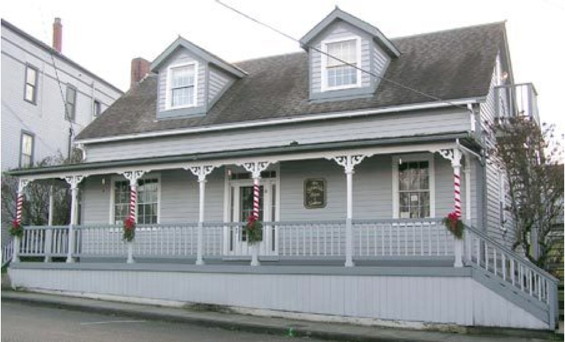
Seaside Spa and Salon
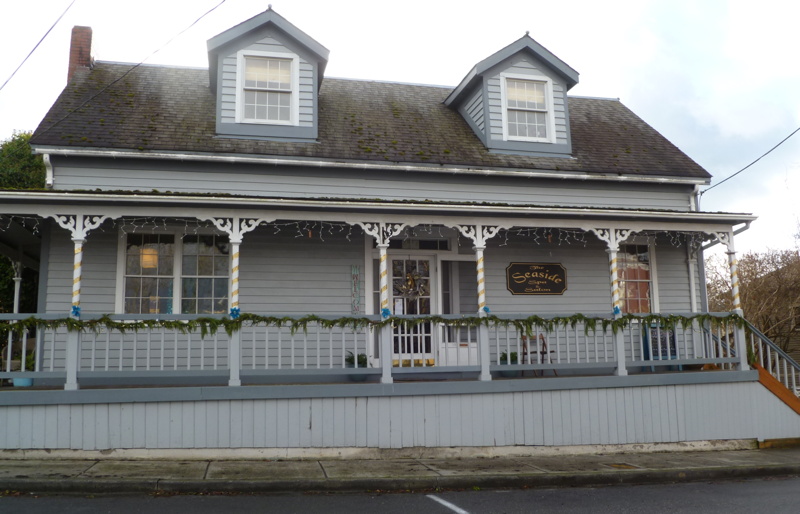
Seaside Spa and Salon
Courtesy: Robert Y Elphick, 2015
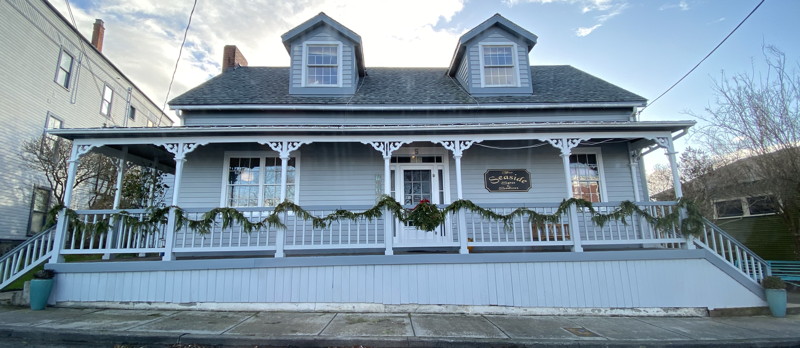
Seaside Spa and Salon
Courtesy: Robert Y Elphick, January 2020
* All the interviews are extracted from the Judy Lynn's Oral History Project. Judy Lynn interviewed everyone she could find who had any memories of the history of Front Street. For more information on the project contact the Whidbey Island Historical Musem, Coupeville.
The e-book Front Street, Coupeville - An Oral History by Judy Lynn contains all the interviews. It can be purchased for $9.99 at Amazon.com for Kindle application or device or from the Apple Store for iBooks applications. Proceeds go to the Island County Historical Society.


